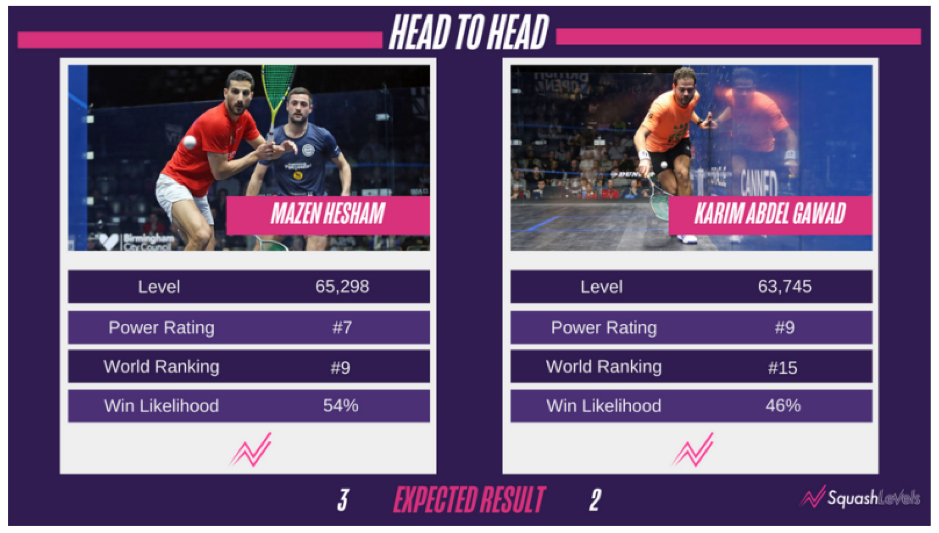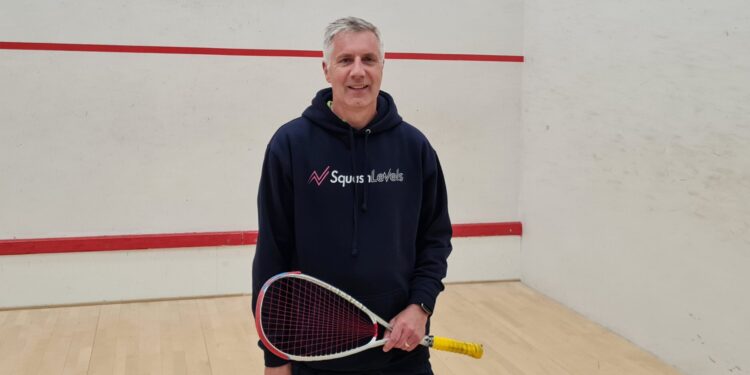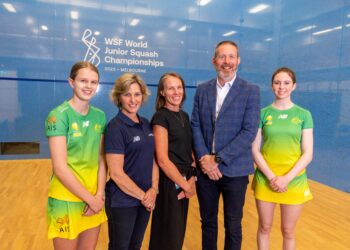Richard Bickers, the founder and co-CEO of SquashLevels, has just got back from a game of Thursday afternoon squash.
“I didn’t play very well, but we weren’t keeping score. I quite like to play the beautiful game and not score, and just bang the ball about,” Bickers (pictured above) confides.
This seems like a startling admission from a man who created a system that rates the standard of around 50,000 squash players worldwide, from Diego Elias and Nouran Gohar to club players and beginners.
But Bickers was quick to add that he has two squash-playing personas – the second, more competitive, of which sees him do battle in the Avon county league, whose results are added to SquashLevels’ database.
Indeed, the kind of friendly competition and camaraderie SquashLevels engenders could be the key to getting more beginners and casual players hooked on the game, Bickers believes.
Talking exclusively to Squash IQ, Bickers outlined his plans for expanding SquashLevels globally and continuing to develop the user experience (including adding a new ‘find-a-player’ feature).
Where software coding meets squash
Having started out as just a hobby for software architect and squash lover Bickers 15 years ago, SquashLevels is today the talk of locker rooms the world over, with 160,000 players (50,000 of which are active) now on its system.
Players on SquashLevels are assigned a ‘level’ that changes with each match based on comparing the expected and actual result.

In the case of new men’s world number Diego Elias (pictured above), this level is around 80,000. For a top club player, it might be around 8,000, while a mid-level club player like Bickers may be on 800.
As the levels are designed to be relative, this makes Elias ten times better than (or, at least, means he is expected to score ten times as many points as) the county player, and 100 times better than Bickers.
“I’m around the 900 mark, which is not exactly stellar – but that’s fairly typical. If I look at my profile, in fact I’ve not played well recently, so I’m down to 800 – and ranked 11,000th in England and 22,000th in the world,” he said.
Reflecting Bickers’ background as a software architect for HP (he retired last year), SquashLevels’ ratings are built on an algorithm not even Carol Vorderman could fully comprehend.
Characterised by Bickers as “a labour of love for 15 years”, it takes into account the player’s level before the match, the opponent’s level before the match, the actual result compared to the expected result, maths, weighting, damping and behavioural modelling (see more here).
But the net result is a snapshot of a player’s current form so precise that the PSA has recently adopted it for its new ‘power ratings’.
Although some of them won’t have twigged, the thousands of spectators who attended the recent British Open saw SquashLevels’ data pop up on the big screens before each match, highlighting the percentage win chance of each opponent (see below).
Based as they are on current form (as opposed to ranking points accumulated over 12 months), the PSA Power Ratings can differ substantially from the PSA World rankings.

‘Players get completely addicted’
Following recent collaborations with squash federations in countries such as Australia and the Netherlands, SquashLevels now has around 3.2m results on its system dating back to the year 2000.
Alongside using traditional marketing methods such as email and social media, the business model is to receive match data from complementary systems such as SportyHQ, League Master and BADSquash, and then wait for word to spread among the players who are its potential subscribers, Bickers explained.
“Quite often, the first time someone knows about SquashLevels is when a friend tells them they are on it, and they might register,” Bickers said.
“They can register for free and get 30 days’ Gold membership, which gives them access to quite a bit of the functionality.
“That’s quite often the way it begins – word of mouth is very powerful and the players get completely addicted, which is lovely.”
Algorithm of love
The idea for SquashLevels began when Bickers agreed to help improve the algorithm used to rank players for his county.

The closest thing to a lightbulb moment occurred a couple of years later, when he realised something important was missing from his calculations.
“In around 2009 or 2010, once people began to realise I was the one who had [improved the algorithm], they started to pin me down at the bar and tell me ‘well, it’s all very well, but it doesn’t allow for this, or that’,” Bickers explained.
“And I began to realise that it couldn’t be as accurate as I wanted it to be if it didn’t include behavioural modelling.”
SquashLevels accounts for around 10 specific behavioural models, including – most importantly – the phenomenon of a good player “playing down” to the level of an inferior one – but also fast improving juniors, tournament behaviour and beginners (see the full list here).
Squash Skills collaboration
Bickers’ coding skills were called into practice on another front just before lockdown when he wrote 40,000 lines of code as part of a complete overhaul of the front end of SquashLevels’ website.

The redesign was at the centre of a wider push to transform SquashLevels from a part-time venture into a more ambitious, global business after Bickers joined forces with Squash Skills’ Jethro Binns.
“I immediately saw the synergy. Squash Skills is all about helping you improve and Squash Levels is about measuring that improvement. We recognised that we could work together and devised a way we could integrate” he said.
“Jethro is pretty good in digital solutions, branding and digital marketing and he is very well connected in the world of squash.
The website looked a bit old-fashioned and he suggested that I take a look at improving the branding, the look and feel and making it mobile friendly.
“I needed Jethro to go global and to do it properly, if you like. Rebranding and making the site mobile-friendly gave us the chance to go global and push out into all these different territories.
“We relaunched in March 2020, which is exactly when Covid struck, so we couldn’t have timed it worse. We had to flog through Covid and come out the other side before we could get more matches coming in and get back to where we wanted to be. It’s really taken off since then.”

Going social
Although Bickers sees the algorithm as the heart of SquashLevels’ proposition, the focus now is as much on boosting the user experience on its website, which he said attracts around 40,000 page hits a day.
“We looked at Strava as something of an inspiration,” Bickers said.
“We looked at what we can offer users that’s really interesting, and decided the direction to go in was social. So we added features like the ability to follow players. We created a feed – if you look at it you can see the results of all the people you are following, and there are things like win streaks and trophies there.”
Adding the ability to create communities has increased the appeal of SquashLevels among federations, counties and clubs, Bickers claimed.
“It gives organisations a way to communicate with their players. The federations we are talking to now – Australia, New Zealand etc – are really keen on making use of these communities and the ability to post to players. So that’s the social direction we’ve gone in.”
New find-a-player feature
Although Bickers has his hands full onboarding new federations (“we might have a quarter of a million results to import, so it’s quite a big deal getting them on board and calibrated”), he and Binns are already looking at what extra functionality they can add next.
The goal is to have a new ‘find-a-player’ feature up and running by the start of the new season, Bickers confirmed.

“That’s the next thing we want to do. Imagine, I’m travelling somewhere in the world and fancy a game of squash. We can offer a process that’s pretty straightforward to find someone to play who’s at about your level,” he explained.
SquashLevels’ growth aspirations
And in terms of player growth, SquashLevels is just getting started, with Bickers estimating that just five per cent of the world’s active squash players are currently on it.
“These are the league level players in the countries we are working with already. We have quite a few club box level players too but the [bulk of the global squash community] is the club players and leisure players and we’re hoping that the engaging nature of having a level and the platform itself will encourage all players of all abilities to get involved.
“It’s really hard to put a figure on it, but I would venture that there are around one million active squash players in the world. I’m not thinking of players that play every six months, but those who play at least once a month.

“These are the guys that may be interested in their level. If we can attract a chunk of those onto the system, that would be pretty good.”
Around 12 per cent of those on SquashLevels are women, while 15 per cent are juniors, Bickers said.
“As everyone knows, it’s a slightly ageing population, but I’m beginning to get optimistic again because there are actually a lot more juniors coming in than there used to be,” he said.
‘You don’t want it turned on all the time’
Addressing concerns that SquashLevels may add unwanted pressure for some players, Bickers stressed that “you don’t want it turned on all the time”.
“There are plenty of people who just want to play a friendly, and not have it recorded because it adds an extra level of pressure,” he said.
“If you’re playing a box game, league or tournament, it makes sense to include the results in the ratings algorithm because they are competitive matches.
“But if you’re just going to bang a ball around to keep fit, or because it’s fun or social-led, it’s fine not to include them. And I don’t take offence.”











